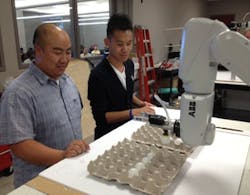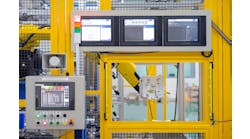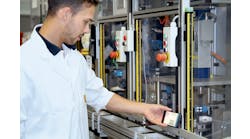Mike Bacidore is the editor in chief for Control Design magazine. He is an award-winning columnist, earning a Gold Regional Award and a Silver National Award from the American Society of Business Publication Editors. Email him at [email protected].
What will the next generation of manufacturing workers look like? One thing is certain. These individuals will be able to work with robots — capable of programming them, as well as allowed to interact with them, side by side.
Ntxuzone Yang and Luede Yang are cousins. The two are students at the University of Arkansas — Fort Smith (UAFS). I met them in the ABB Robotics lab when I toured it as part of the Baldor Publishers Tour in November 2014. The lab's robots comprise mostly ABB's IRB 120 model, some donated and the rest discounted. The Yangs are part of the new wave of industrial technology and automation, thanks largely to their participation in the UAFS program. And robotics will play an equally important role, especially now with the introduction of collaborative robots.
"We see several cases where robots designed for power- and force-limiting applications, such as ABB YuMi, Universal, Baxter and Kuka LBR iiwa, are called 'collaborative robots,'" explains Pat Davison, director of standards development at Robotic Industries Association in Ann Arbor, Michigan. "This is a bit of a misnomer. It would be more appropriate to call these 'power- and force-limiting robots.' Furthermore, any collaborative situation is going to depend on the application, or what the robot is doing, as a condition of determining whether perimeter guarding will be necessary. I understand these concepts make the collaborative robot discussion a bit more complicated, but not being explicit in these clarifications seems to create confusion or the potential for misapplication, which is something the standards development community hopes to avoid."
Also read: Robot Buddies
Ntxuzone Yang and Luede Yang are cousins and students working with ABB Robotics in the program at University of Arkansas — Fort Smith.
Davison warns companies against wanting to deploy a collaborative robot to avoid devoting capital or floor space for machine guarding. "We see this as putting the cart before the horse," he explains. "A more appropriate deployment from the standards development perspective is that a company identifies an application it wishes to automate and, through a risk assessment, determines that deploying a collaborative robot application would not pose an unacceptable risk to personnel and proceeds with designing the cell with an appropriate level of safeguarding."
Human-robot collaboration will only become more important, predicts Per Vegard Nerseth, global head of the robotics business at ABB. "To meet the flexible and agile production needs required in the consumer electronics industry, and increasingly in other market sectors, ABB has developed YuMi, a dual-arm small parts assembly robot that can collaborate, side by side, with humans in a normal manufacturing environment enabling companies to get the best out of both humans and robots, together," he explains. "The intrinsically safe design of the robot with soft padded dual arms combined with innovative force-sensing technology ensures the complete safety of human co-workers. Its 'intrinsically safe' rating means it can work alongside humans without posing any risk whatsoever to their safety. We expect that it will be mostly employed in the consumer electronics industries and will focus our initial efforts there, but clearly it has potential beyond those industries."
Continued development of safety standards in the United States and internationally are helping to enable the evolution of these applications in new industries. "ISO 10218 and ANSI/RIA R15.06-2012 set forth four different modes of collaborative operation," explains Davison. "These different modes can use a variety of technology to achieve the criteria in the standard. The standard sets the requirements for the robots or robotic applications, but it doesn't specify which technologies must be used. For safety-rated monitored stop and hand guiding, improvements in controls technology is the enabling factor. For speed and separation monitoring, area scanners help to identify the locations of potential hazards or obstacles, and the controls technology ensures the robot reacts appropriately. For power- and force-limiting applications, technologies being used include the controls technology and mechanical actuators that allow the joints to give in contact situations.
Additionally, larger surface areas, elimination of pinch points by offsetting axes, padding and other design factors can all contribute."
A new technical specification addresses the potential for incidental contact between robots and humans. "We had been awaiting the results of the study taking place at the University of Mainz regarding the onset of pain at various body regions," explains Davison. "The study is now complete, and the working group has an agreement in principle on how the study results will be used in setting guidance on power and force limits. I am optimistic that the TS will be published in 2015."






